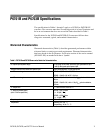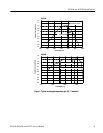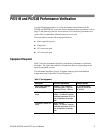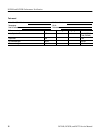
P6701B and P6703B Performance Verification
P6701B, P6703B, and P6723 Service Manual
9
Output Zero
1. Attach 1103 powered P670XB output to voltmeter with 50 ohm termination.
2. Install optical dust cover on input to P670XB under test.
3. Check that output voltage is ≤ 1mV.
DC Conversion Gain
NOTE. Make sure that the optical connector ends of both the fiber jumpers and
the input fiber of the O/E converter under test are well cleaned before perform-
ing this step. Use isopropyl alcohol, lint-free lense paper and clean compressed
air to clean the fiber ferrule ends. Refer to page 17 for the recommended
cleaning procedure.
1. Connect 780 nm laser to attenuator.
NOTE. The fiber bend radius of the P670XB fiber input should lay with >1-inch
bend radius along the fiber’s entire length. Although this precaution must be
maintained throughout the entire PV procedure, it is especially important for this
step in order to accurately adjust and measure DC-conversion gain of the
P670XB.
2. Connect FC connector of the optical attenuator to FC-receptacle of the
optical power meter using the optical cable. Use the appropriate optical
power meter sensing head with calibrated measurement for a wavelength
span including 780 nm and 850 nm. Be sure the optical power meter
wavelength setting is at 780 nm.
3. Adjust attenuator or the optical source source so that the power meter reads
100 W.
4. Move the FC fiber end (the one now adjusted to 100 W average power)
from the optical power meter and connect to the P670XB input under test by
using the FC-FC inline female-female optical adapter.
5. Attach voltmeter with 50 ohm termination to 1103 powered P670XB output.
6. Check for 100 mV reading on voltmeter, ± 8%. (The 780 nm conversion gain
is 1.00 V/mW.)
P6701B


















